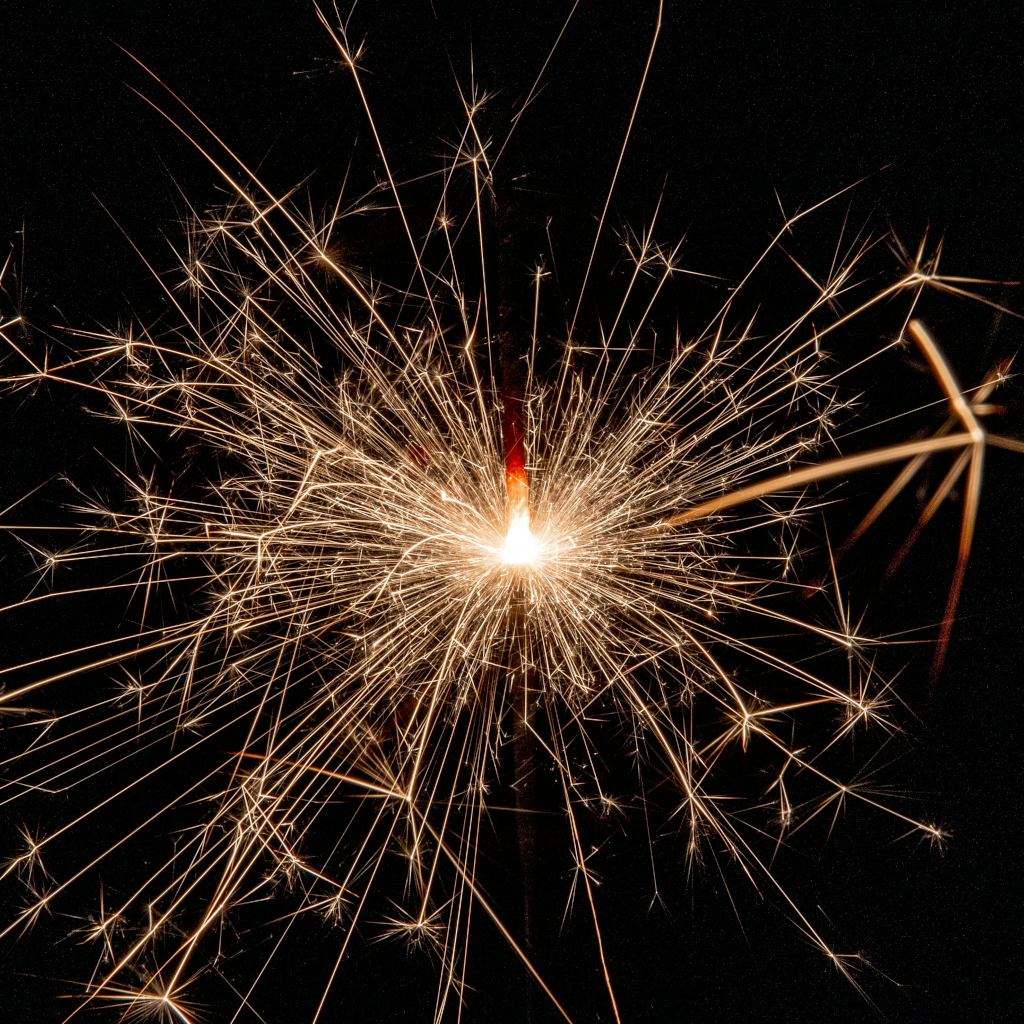


Sparklers are fascinating pyrotechnic products that produce a characteristic sparking and glowing phenomenon. Their spectra are an ideal and easily accessible light source that can be used to demonstrate that excited atoms can not only generate emission lines, but can also cause absorption lines by absorbing radiation of the same wavelength.

A sparkler usually consists of a thin, stable metal (often steel wire) that serves as a carrier for the pyrotechnic mixture. The rod remains stable during burning and serves as a handle.
A thick layer of a pyrotechnic mixture is applied to this rod. It usually contains potassium perchlorate (KClO4) or potassium chlorate (KClO3) as an oxidizing agent. Coal or sugar is often used as fuel. Metal powders such as aluminum, magnesium or iron are responsible for the spark formation and the characteristic appearance. Binding agents such as starch or dextrin, mixed with water or alcohol, hold the mixture on the stick. An additional highly flammable mixture is sometimes used at the top of the sparkler to make it easier to light.
The ignition tip is ignited by a flame or spark. The resulting heat causes the pyrotechnic coating to burn. The oxidizing agent releases oxygen, which enables the fuel to burn. The metal particles in the mixture heat up strongly and burn with intense sparking. The glowing metal particles are propelled into the air by the combustion, oxidizing and producing bright sparks before they cool down.
Caution: Sparklers generate high temperatures (over 1000 °C) and harmful smoke, so they should only be used in well-ventilated areas and with caution.
Sparklers produce a continuous spectrum when burning, which is mainly generated by the thermal emission of the glowing metal particles. This is a continuum whose shape depends on the temperature of the glowing particles (e. g. iron, aluminum or magnesium) and the materials used.
The continuous spectrum of a sparkler essentially corresponds to a Planck curve for temperatures between 2000 K and 3000 K. It therefore shows a high intensity in the red and yellow range, with decreasing intensity towards blue and UV wavelengths. Additional narrow spectral lines can occur due to chemical additives (e. g. sodium, barium, potassium) and overlay the continuous spectrum.
The exact properties of the continuous spectrum depend on the materials used in the sparkler. Iron or steel powder results in a spectrum with intense radiation in the red and infrared range, while magnesium provides a brighter spectrum with more emission in the blue and UV range as it reaches higher temperatures. Aluminum behaves similarly to iron, but with a stronger emission in the mid-visible range.
The size of the metal particles also influences the intensity of the radiation. Fine particles glow faster and reach higher temperatures, producing a brighter and broader spectrum. Coarse particles, on the other hand, glow more slowly and cooler, making the spectrum more intense in the red range.
Emissions of metals and salts contained in the sparkler can often be seen above the continuous spectrum. The characteristic yellow D-line of sodium (~589 nm) and two typical peaks of potassium (~766 nm, ~770 nm) in the infrared range are frequently found.
The spectrum shown was recorded with one of our DIY spectrometers. A normal test tube was placed over the light guide to protect it. This allowed it to be placed relatively close to the burning sparkler.
If several spectra are recorded during the burning of a sparkler, it is usually observed that some of the typical peaks of metals and salts contained in the sparkler generate an additional peak on the continuous spectrum through emission and sometimes cause a dip because the corresponding wavelength is absorbed. This can be observed particularly well with the very dominant sodium D line (~589 nm).
Emission of the sodium D-line occurs when the temperature is high enough to generate sodium atoms and bring them into excited states. Cold or less excited sodium atoms in the vicinity of the hot flame, on the other hand, absorb light in the region of the D-line. As a result, a dip appears in the spectrum at this point, as the light in this area is attenuated.
Whether a peak or a dip is visible at ~589 nm depends dynamically on the prevailing balance between emission and absorption in the area of the flame that the spectrometer's light guide picks up. Since the burning of the sparkler does not produce stable combustion zones, but is rather chaotic, the local conditions are constantly changing. If the emission is dominated by excited sodium atoms, it overlaps the absorption. If, on the other hand, more light is absorbed by cold sodium vapors than is compensated for by emission, a dip in the spectrum occurs.
The observed balance is influenced by local flame conditions:
The spectrum shown here was recorded using a commercially available sparkler, as sold for table fireworks of category F2.
To protect the light guide, an appropriately sized test tube was slid over it and positioned in front of the sparkler at a distance of a few millimeters using clamps.
We also used one of our DIY spectrometers:
 Would you like to replicate the experiment—in your laboratory or teaching environment? Feel free to contact us—we will assist you with planning, setup, calibration, and selecting the right components. Eureca offers advice based on many years of expertise in optoelectronics, optics and spectroscopy—from DIY setups to OEM solutions. Feedback is expressly welcome: Please share your experiences, results, or suggestions for improvement with us.
Would you like to replicate the experiment—in your laboratory or teaching environment? Feel free to contact us—we will assist you with planning, setup, calibration, and selecting the right components. Eureca offers advice based on many years of expertise in optoelectronics, optics and spectroscopy—from DIY setups to OEM solutions. Feedback is expressly welcome: Please share your experiences, results, or suggestions for improvement with us.
Here you can easily ask a question or inquiry about our products:
Last update: 2025-31-10
